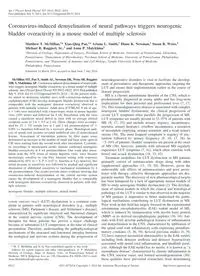
2014 Coronavirus-induced demyelination of neural pathways triggers neurogenic bladder overactivity in a mouse model of m PDF
Preview 2014 Coronavirus-induced demyelination of neural pathways triggers neurogenic bladder overactivity in a mouse model of m
Coronavirus-induced demyelination of neural pathways triggers neurogenic bladder overactivity in a mouse model of multiple sclerosis Matthew T. McMillan,1* Xiao-Qing Pan,1* Ariana L. Smith,1 Diane K. Newman,1 Susan R. Weiss,2 Michael R. Ruggieri, Sr.,3 and Anna P. Malykhina2 1Division of Urology, Department of Surgery, Perelman School of Medicine, University of Pennsylvania, Glenolden, Pennsylvania; 2Department of Microbiology, Perelman School of Medicine, University of Pennsylvania, Philadelphia, Pennsylvania; and 3Department of Anatomy and Cell Biology, Temple University School of Medicine, Philadelphia, Pennsylvania Submitted 14 March 2014; accepted in final form 7 July 2014 McMillan MT, Pan X, Smith AL, Newman DK, Weiss SR, Ruggieri MR, S, Malykhina AP. Coronavirus-induced demyelination of neural path- ways triggers neurogenic bladder overactivity in a mouse model of multiple sclerosis. Am J Physiol Renal Physiol 307: F612–F622, 2014. First published July 9, 2014; doi:10.1152/ajprenal.00151.2014.—In the present study, we aimed to determine whether mice with coronavirus-induced en- cephalomyelitis (CIE) develop neurogenic bladder dysfunction that is comparable with the neurogenic detrusor overactivity observed in patients with multiple sclerosis. Adult mice (C57BL/6J, 8 wk of age, n � 146) were inoculated with a neurotropic strain of mouse hepatitis virus (A59 strain) and followed for 4 wk. Inoculation with the virus caused a significant neural deficit in mice with an average clinical symptom score of 2.6 � 0.5 at 2 wk. These changes were accompa- nied by 25 � 5% weight loss at 1 and 2 wk postinoculation (P � 0.001 vs. baseline) followed by a recovery phase. Histological anal- ysis of spinal cord sections revealed multifocal sites of demyelinated lesions. Assessment of micturition patterns by filter paper assay determined an increase in the number of small and large urine spots in CIE mice starting from the second week after inoculation. Cystomet- ric recordings in unrestrained awake animals confirmed neurogenic bladder overactivity at 4 wk postinoculation. One week after inocu- lation with the A59 strain of mouse hepatitis virus, mice became increasingly sensitive to von Frey filament testing with responses enhanced by 45% (n � 8, P � 0.05 vs. baseline at 4 g); however, this initial increase in sensitivity was followed by gradual and significant diminution of abdominal sensitivity to mechanical stimulation by 4 wk postinoculation. Our results provide direct evidence showing that coronavirus-induced demyelination of the central nervous system causes the development of a neurogenic bladder that is comparable with neurogenic detrusor overactivity observed in patients with mul- tiple sclerosis. neurogenic bladder; multiple sclerosis; animal model LOWER URINARY TRACT (LUT) dysfunction is a common com- plaint in patients with neurological disorders [e.g., multiple sclerosis (MS), Parkinson’s disease, and Alzheimer’s disease], characterized by significant structural and functional changes in the central nervous system (CNS). The development of therapies for these patients has proven a major challenge because of substantial LUT compromise at the time of clinical presentation. Therefore, understanding the pathophysiological mechanisms of the structural and functional interplay between the urological and nervous systems during the progression of neurodegenerative disorders is vital to facilitate the develop- ment of preventative and therapeutic approaches targeting the LUT and ensure their implementation earlier in the course of disease progression. MS is a chronic autoimmune disorder of the CNS, which is predominantly diagnosed in young adults and has long-term implications for their personal and professional lives (7, 17, 35). This neurodegenerative disease is associated with complex neurogenic bladder dysfunction; the clinical progression of severe LUT symptoms often parallels the progression of MS. LUT symptoms are usually present in 32–97% of patients with MS (9, 17, 35) and include urinary urgency, incontinence, nocturia, urinary hesitancy, overflow incontinence, a sensation of incomplete emptying, urinary retention, and a weak urinary stream (38). The most frequent complaint is urgency of mic- turition followed by urinary frequency (9, 10, 17, 38). In �5–10% of patients, bladder symptoms are present at the onset of MS (38); however, patients with advanced MS regularly experience LUT symptoms (7, 41), which often correlate with bowel and sexual dysfunction (18, 33, 42). Treatment modalities for LUT dysfunction in MS patients primarily consist of antimuscarinic drugs along with other supplemental approaches (11, 19, 50). However, given the unfavorable side effects of antimuscarinics and poor persis- tence with therapy, effective therapeutic approaches are des- perately needed. The discovery of new pharmacological targets has been hampered by a lack of appropriate animal models of MS to study neurogenic bladder dysfunction (2). The develop- ment of animal models in which the clinical and histological pathology of the LUT is similar to that observed in the majority of MS patients is imperative to better understand the patho- logical mechanisms contributing to LUT dysfunction in MS. Prior work in this field has largely focused on the experimental autoimmune encephalomyelitis (EAE) rodent model of MS, which is induced by immunization with myelin basic protein (MBP) or its derived encephalitogenic peptides (30, 34). Ani- mals with EAE develop pathological features of inflammation and demyelination in the CNS, characterized by infiltration of the spinal cord with inflammatory cells expressing proinflam- matory cytokines (5, 36, 39). Several previous studies (5, 39, 52) have reported micturition abnormalities in the EAE model, including both detrusor areflexia and detrusor hyperactivity associated with spinal cord inflammation, and hindlimb paral- ysis. Although the EAE model has its merits, it is known as “a monophasic disease” characterized by chronic inflammation in the CNS, unclear onset, and limited neurodegeneration (30); these qualities have prevented researchers from determining * M. T. McMillan and X.-Q. Pan contributed equally to this work. Address for reprint requests and other correspondence: A. P. Malykhina, Division of Urology, Dept. of Surgery, Univ. of Pennsylvania School of Medicine, 500 S. Ridgeway Ave, no. 158, Glenolden, PA 19036-2307 (e-mail:
